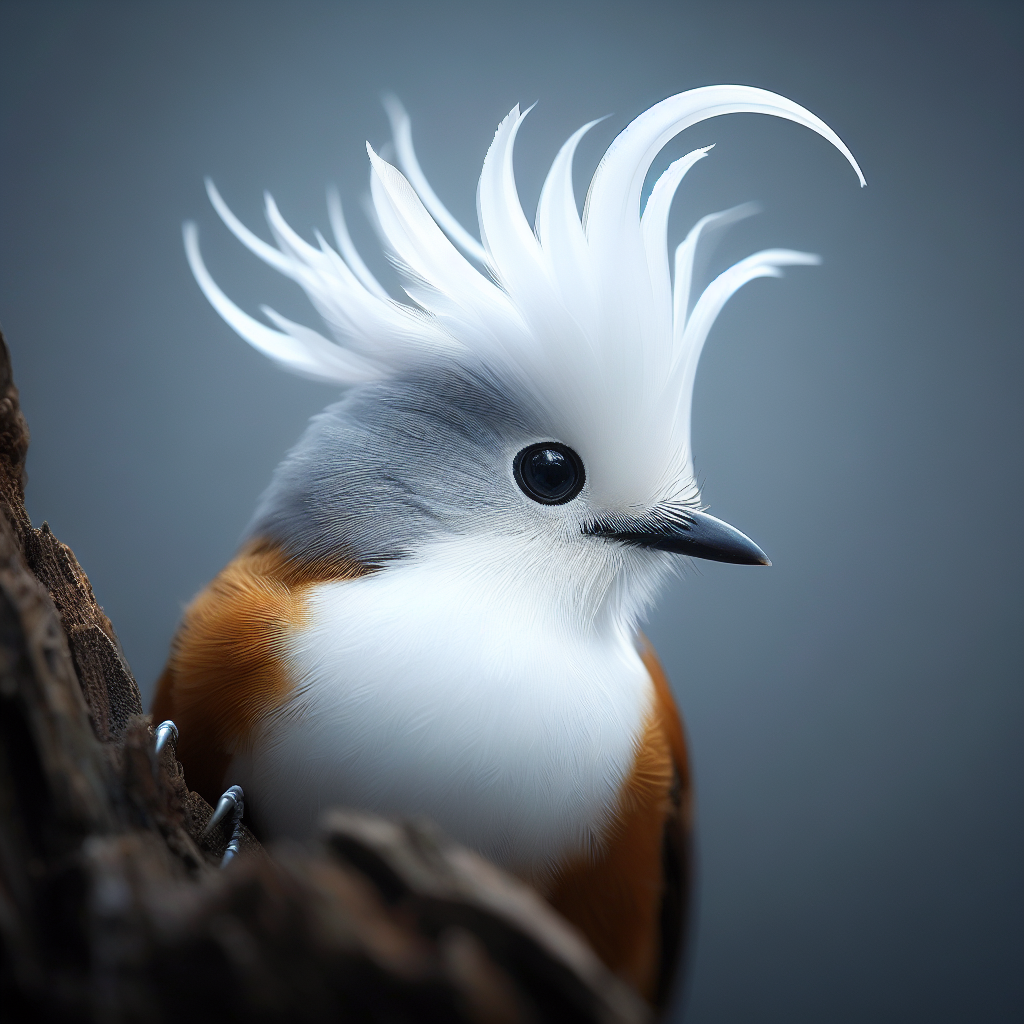Most beautiful small birds - Sykalo Eugen 2024
White-crested Laughingthrush (Garrulax leucolophus)
Identification:
- Species name: White-crested Laughingthrush
- Scientific name: Garrulax leucolophus
- Family: Leiothrichidae
- Order: Passeriformes (Songbirds)
- Subclass: Neornithes (Modern birds)
- Class: Aves (Birds)
Description:
- Size: A medium-sized thrush, about 22-25 cm (8.7-9.8 in) long with a wingspan of 33-38 cm (13-15 in).
- Body shape: Slender and agile, with a long, slightly downcurved beak, a long, rounded tail, and a distinctive white, fan-shaped crest that rises and falls with emotion.
- Plumage color:
Upperparts: Rich russet brown, fading to paler on the back and wings.
Underparts: Lighter brown, fading to buff on the belly.
Black mask around the eyes extends to the base of the beak.
Long, slightly downcurved black beak perfect for foraging on the ground and in dense foliage.
Strong, pinkish-gray legs for navigating undergrowth and hopping among branches.
Large, dark brown eyes that scan for insects and fruits.
Behavior:
- Method of feeding: Omnivorous, eating a variety of fruits, insects, spiders, worms, and other small invertebrates. Forages on the ground, in vegetation, and on branches.
- Reproduction: Builds cup-shaped nests in bushes or low trees. Lays 2-5 pale blue eggs with dark speckles. Both parents care for the young.
- Movement: Primarily resident, with some local movements in response to food availability.
- Communication: Loud, boisterous calls and whistles, often rising to a deafening chorus, especially when foraging or defending territory. Each individual has its own unique song variation.
Ecology:
- Habitat: Primary and secondary forests, scrublands, gardens, and even urban parks. Prefers areas with dense vegetation and plenty of undergrowth.
- Diet: Fruits, insects, spiders, worms, snails, and other small invertebrates. Plays an important role in seed dispersal.
- Hunting methods: Forages on the ground, hopping and scratching amidst leaf litter, or gleans insects from leaves and branches. May also catch flying insects mid-air.
Distribution: Found in the Himalayas and Southeast Asia, from India and Nepal to Vietnam and Thailand.

The White-crested Laughingthrush, a feathered jester painting the tropical forests with flashes of black and white and echoing bursts of infectious laughter. This resident of bamboo thickets might seem like a simple songbird at first glance, but beneath its mischievous personality and seemingly playful calls lies a treasure trove of surprising facts and adaptations that will transform this forest comedian into a captivating social explorer, hidden feast master, and unexpected ecosystem engineer in your eyes.
Masters of the Bamboo Labyrinth: Forget clumsy hops; White-crested Laughingthrushes reign supreme in the domain of sun-dappled bamboo groves and tangled undergrowth. Their powerful legs and surprisingly acrobatic skills propel them through the dense foliage with breathtaking agility, weaving and slipping like feathered parkour experts on miniature jungle gyms. Imagine them as bamboo forest gymnasts with built-in miniature climbing claws and an innate love for labyrinthine adventures.
Hidden Feasting Technique: Don't underestimate their dietary flexibility! While insects and fruits are staples, White-crested Laughingthrushes are opportunistic omnivores, readily adapting their menu to seasonal bounty. From juicy shoots and tender leaves to grubs and even the occasional small snake, their varied appetite keeps them fueled for energetic foraging sessions. Think of them as feathered forest gourmands with built-in miniature buffets hidden within the emerald maze.
Singing with Infectious Spirit: Their calls aren't just chirps and whistles. White-crested Laughingthrushes possess a distinctive and surprisingly humorous repertoire, with clear, piping songs, intricate trills, and their signature, contagious "chuckle-chuckle-chuckle" chorus that echoes melodically through the bamboo stems. Their voices rise above the forest like feathered comedians, spreading laughter and playful camaraderie amongst their social cohorts.
Unexpected Social Explorers: They're not always solitary singers. White-crested Laughingthrushes live in close-knit family groups, venturing out in coordinated foraging parties and engaging in synchronized aerial antics that paint fleeting patterns of feathered unity across the forest canopy. These feathered socialites, in playful chases and intricate communication networks, become living tapestries of cooperation and shared knowledge within the verdant labyrinth.
Champions of Ecosystem Health: They're not just colorful residents. White-crested Laughingthrushes play a vital role in the health of tropical ecosystems. Their insect feasting controls pest populations, while their droppings fertilize the soil, making them feathered forest doctors with built-in miniature pest-control systems and environmental beautification kits.
Accidental Ecosystem Engineers: They're not just playful pranksters. As they forage and navigate through the bamboo stalks, White-crested Laughingthrushes inadvertently create pathways and clearings that benefit other smaller animals and insects. This feathered forest landscaper, with its built-in miniature trail-blazing instincts, becomes an unexpected architect of biodiversity within the dense undergrowth.
Cultural Charmers: Across Southeast Asia, the White-crested Laughingthrush has held diverse cultural significance. In some regions, its playful laughter is seen as a symbol of joy and good fortune. In others, its presence in bamboo forests is considered a blessing for a bountiful harvest.
Unexpected Regional Variations: Did you know? Not all White-crested Laughingthrushes are the same! Different populations across their vast range show subtle variations in plumage color and call patterns, adding a touch of feathered diversity to this adaptable species.